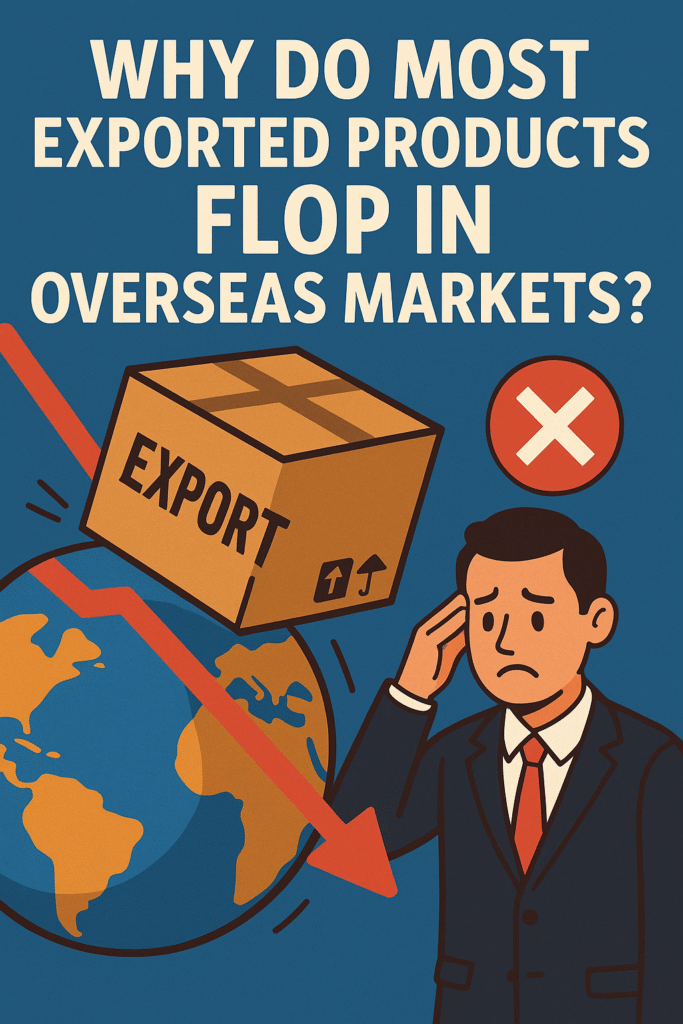Entering international markets is a dream for many exporters. It promises expanded customer bases, higher revenues, and global brand recognition. Yet, despite the opportunities, a large percentage of exported products fail or flop in overseas markets. Why does this happen?
The reasons are not merely logistical or financial. Most failures stem from a lack of preparation, inadequate market understanding, and poor strategic execution. In this blog post, we explore the top reasons why exported products fail—and how you can avoid them.
1. Lack of Market Research
One of the most common reasons for failure is insufficient research on the target market. Exporters often assume that what works in their home country will work abroad. But international markets vary significantly in terms of:
- Consumer preferences and behaviors
- Economic conditions
- Legal and regulatory environments
- Cultural sensitivities
Example: A food product popular in India may flop in Europe due to unfamiliar flavors, packaging, or even dietary restrictions.
Solution: Invest in professional market research. Understand your target audience, their needs, habits, and pain points before launching.
2. Cultural Misalignment
Culture impacts everything—from color preferences and communication styles to product usage and branding. A product or advertisement considered trendy in one country might be offensive or confusing in another.
Example: A brand using red packaging (associated with excitement in the West) may struggle in some Asian countries where red signifies danger or warning in certain contexts.
Solution: Localize your product, packaging, and marketing messages. Hire local consultants or partners to guide you on cultural nuances.
3. Non-Compliance with Local Regulations
Each country has its own laws regarding imports, product safety, certifications, and labeling. Ignoring these requirements can result in goods being rejected at the border, legal penalties, or even permanent bans.
Example: Electronics exported to the EU without CE certification can be confiscated or fined.
Solution: Study and comply with international trade regulations, certifications, and labeling norms before exporting.
4. Wrong Pricing Strategy
Pricing a product for a foreign market involves more than just currency conversion. Exporters often fail to account for import duties, taxes, logistics, distributor margins, and customer purchasing power.
Example: An Indian exporter pricing industrial tools similarly in Latin America without considering local affordability can quickly lose to domestic or Chinese competitors.
Solution: Develop a country-specific pricing model that includes all cost elements and reflects local market conditions.
5. Poor Distribution Channels
Choosing the wrong distributor or partner can be fatal. Many exporters sign up with agents or distributors without evaluating their capabilities, reach, or commitment to the brand.
Example: An exporter relying on a single distributor who lacks retail network access may face stagnant sales or brand invisibility.
Solution: Perform due diligence. Vet your partners thoroughly, establish KPIs, and maintain strong communication.
6. Inadequate After-Sales Service and Support
Overseas customers expect reliable after-sales support, especially for technical, industrial, or electronic products. If your product malfunctions and there’s no local service center or support, your brand image can take a massive hit.
Solution: Plan your after-sales service in advance—either through local partners, service centers, or clear return policies.
7. Overlooking Branding and Positioning
What makes your product unique? Why should someone in another country choose it over a local alternative? If your brand messaging doesn’t connect with the local market, it will get ignored.
Example: Positioning a product as “affordable” in the Middle East may backfire, as premium and luxury perceptions often drive purchase decisions.
Solution: Tailor your brand positioning to align with local consumer psychology and market gaps.
Final Thoughts: Exporting Is Not Just Selling—It’s Localizing
Global success isn’t just about having a good product—it’s about making that product relevant in a new market. Exporting is a long-term commitment that requires strategy, adaptability, and empathy toward foreign consumers.
So, if your exported product flopped overseas, it’s not the end—it’s a learning opportunity. Go back to the drawing board, realign your strategy, and enter the market with sharper insight and a localized approach.
🌍 Need Help Entering New Markets?
At EximTutor, we offer personalized consultancy and export-import training to help businesses succeed globally. Reach out to us for expert guidance, market entry strategies, and end-to-end support in your export journey.

